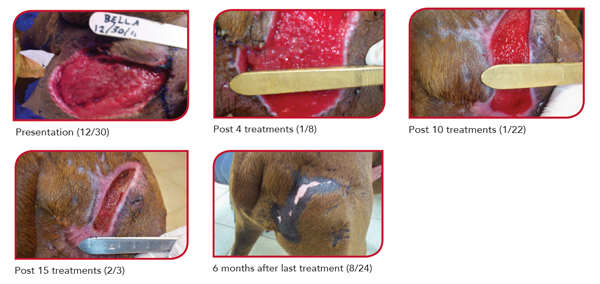Signalment: Canine, 5 yrs., F/S, Boxer, “Bella”.
History: Patient presented with complete dehiscence of previous surgical site of MCT removal. The owners had just moved into town and the patient had the growth removal just prior to moving.
Diagnostics and Exam Findings: Patient stable on physical exam. Previous DVM’s records showed Grade 1 MCT removal at site and use of pedicle flap in closing defect (pedicle had necrosed and fully dehisced subsequently). Histopath report showed narrow, clean margins.
Laser Treatment: 4.9 J/cm² delivered to target site, utilizing the preset wound treatment protocol, delivered 492 total joules to the hip area (100cm²). A non-contact technique was used utilizing the small non-contact treatment head in a linear manner including target tissues and surrounding healthy tissue margins. Treatment-specific technique adaptation of delivery: focused 75% total target dosage (TTD) over active site of contraction at wound edges, 25% TTD over granulation bed.
Frequency of Treatment: Initially post-op, then applied a phasic tapering technique of every other day for three weeks, then every 3-4 days for the next three weeks, for a total of 18 treatments. Laser/photobiomodulation therapy treatments coincided with bandage changes.
Other Treatments: Initially performed surgical debridement of non-viable tissue and partial closure, followed by regular photobiomodulation therapy and non-occlusive tie over bandage to keep area clean while healing.
Comments: It is important to note that even though margins were clean, they were narrow and as such obtained informed client consent since using PBM in post tumor removal area is a situation for special consideration. “Initially saw active development of healthy granulation tissue bed within about 3-4 days post-op surgical debridement with clear evidence of contraction at wound margins. There was some mild dehiscence again at edge of second surgical line at this time but no further progression. Further contraction with very healthy granulation tissue noted throughout therapy. Clear epithelial cell migration/growth at all margins noted early in the treatment phase as well, and granulation bed continued to shrink exponentially throughout course of treatment.
This case was an excellent example of the therapy laser’s assistance in cases where 2nd intention healing is required due to tissue necrosis or previous surgical failure. Based on previous experiences with cases like these, the healing time was reduced by nearly 70% (healed in 1/3 the time) with markedly improved tensile strength as compared to typical scar tissue. As well, there has been no recurrence of neoplasia at the site, years later.”



